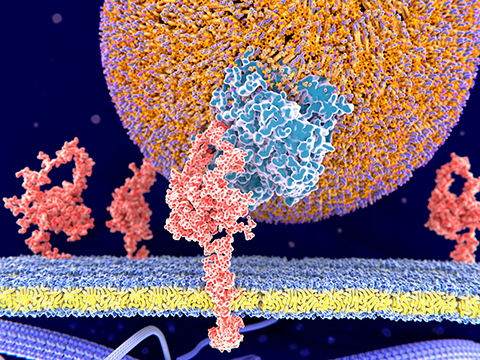From the journals: JLR
A promising oral compound to treat high cholesterol. Synchronizing liver metabolism with lactation. A new way to collect intestinal lymph. Read about papers on these topics recently published in the Journal of Lipid Research.
A promising oral compound to treat high cholesterol
Balance of plasma cholesterol levels is achieved by the liver, the main site of production and recycling, working with peripheral tissues, the main sites of uptake for utilization. Cholesterol flux is mediated by low-density lipoprotein, or LDL, and high-density lipoprotein, or HDL, and by their respective surface receptors.

Disturbances in plasma lipid homeostasis, such as elevation in LDL cholesterol, are linked to a higher risk of cardiovascular disease.
Alexandra K. Suchowerska of Nyrada Inc. in Australia and a group of international collaborators studied the effects of NYX-PCSK9i, a small-molecule inhibitor of the enzyme PCSK9, on plasma cholesterol levels. In the liver, PCSK9 binds to the LDL receptor in the surface of the hepatocyte, stimulating its internalization and degradation, thus impeding LDL cholesterol clearance and favoring accumulation in plasma. Their findings recently were published in the Journal of Lipid Research.
The researchers showed that NYX-PCSK9i disrupts PCSK9–LDLR interaction, thus preventing LDL receptor degradation and maintaining LDL cholesterol uptake. Compound NYX-PCSK9i reduced plasma total cholesterol up to 57% and increased fecal cholesterol excretion when fed to mice that were altered genetically to have elevated cholesterol. Levels of HDL cholesterol were not changed.
Established cholesterol drugs such as statins often increase PCSK9 serum levels in humans. The study found that NYX-PCSK9i enhanced the effect of the anti-cholesterol drug atorvastatin, further reducing cholesterol up to a total of 65% and setting a precedent for future clinical trials.
More research is needed to confirm the mechanism by which NYX-PCSK9i inhibits the PCSK9 enzyme and preserves LDL cholesterol clearance by the liver.
Synchronizing liver metabolism with lactation
After a person gives birth to a baby, their brain communicates with the metabolic organs by means of prolactin to ensure nutrients get to the mammary gland for milk production. The baby’s suckling creates a positive feedback mechanism that keeps prolactin levels high and influences parental metabolism to support milk production.
In human milk, lipids contribute up to 50% of the energy content, in part via triacylglycerols synthesized in the liver. However, researchers do not yet fully understand the mechanism that protects a lactating person from excessive liver fat accumulation, known as hepatic steatosis.
In a recent article in the Journal of Lipid Research, Maria A. Ramos–Román and colleagues from the University of Texas Southwestern Medical Center and other institutions across the U.S. studied the relationship between liver metabolism and lactation six weeks after birth.
Compared with formula-feeding parents, they found that lactating parents had lower fasting plasma insulin with greater adipose tissue insulin sensitivity, higher endogenous glucose production and higher high-density lipoprotein cholesterol.
Parents with elevated prolactin during lactation had lower intrahepatic triacylglycerol levels, and fatty acids were readily shuffled from the liver into the circulation as very low density lipoprotein triglyceride particles, thus preventing accumulation, the researchers found. Furthermore, lactating parents had increased uptake of these particles by peripheral tissues, resulting in beneficially lower plasma levels.
A new way to collect intestinal lymph
Intestinal trafficking of nutrients, drugs and cells follows one of two routes depending on the physicochemical characteristics of the cargo in question. Once inside an absorbent cell in the colon, cargo can reach the general circulation directly via the portal vein or indirectly via mesenteric lymphatic vessels. The latter route is important for the absorption of dietary lipids, in particular long-chain free fatty acids and triacylglycerols, packed into lipoproteins such as chylomicrons.
In a recent article in the Journal of Lipid Research, Nikolaos Dedousis and colleagues at the University of Pittsburgh describe a new technique to collect mesenteric lymph from mice and to isolate intestinal chylomicrons and immune cells.
The authors modified an existing two-day technique to a single-day surgery with higher survival and greater lymph retrieval in mice. A cannula was placed in the duodenum to infuse lipids, and another cannula was placed in the mesenteric lymph duct to collect lymph every hour for six hours after feeding.
The team analyzed the mesenteric lymph isolated by this technique and found that secretion of triacylglycerols peaked three hours after the lipid infusion and that levels were three times higher than the two-day technique. They also found immune cells positive for CD45 and CD4 markers and regulatory T cells in the retrieved mesenteric lymph.
Enjoy reading ASBMB Today?
Become a member to receive the print edition monthly and the digital edition weekly.
Learn moreGet the latest from ASBMB Today
Enter your email address, and we’ll send you a weekly email with recent articles, interviews and more.
Latest in Science
Science highlights or most popular articles

Genetics studies have a diversity problem that researchers struggle to fix
Researchers in South Carolina are trying to build a DNA database to better understand how genetics affects health risks. But they’re struggling to recruit enough Black participants.

Scientists identify new function of learning and memory gene common to all mammalian brain cells
Findings in mice may steer search for therapies to treat brain developmental disorders in children with SYNGAP1 gene mutations.

From the journals: JBC
Biased agonism of an immune receptor. A profile of missense mutations. Cartilage affects tissue aging. Read about these recent papers.

Cows offer clues to treat human infertility
Decoding the bovine reproductive cycle may help increase the success of human IVF treatments.

Immune cells can adapt to invading pathogens
A team of bioengineers studies how T cells decide whether to fight now or prepare for the next battle.

Hinton lab maps structure of mitochondria at different life stages
An international team determines the differences in the 3D morphology of mitochondria and cristae, their inner membrane folds, in brown adipose tissue.

